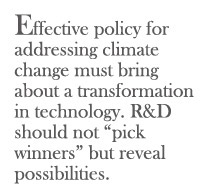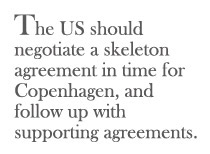How to Prevent the Climate Change Summit From Failure
How to Prevent the Climate Change Summit From Failure

It is easier to define failure. Most climate watchers would define failure to mean lack of an agreement by states to “commit” to limiting their emissions dramatically. I would define failure to mean repeating the mistakes made in
 It is most unlikely that the
It is most unlikely that the
The chances that Congress will approve climate change legislation before
It is more realistic to aim to negotiate a skeleton agreement in time for
Indeed, there is a feedback between domestic negotiations in
 Congress will be especially concerned about
Congress will be especially concerned about
The participation of these countries is also important for another reason. If the
How should a new treaty be designed? The focus has been on the negotiation of a new set of economy-wide targets and timetables. The European Union unilaterally set the goal of reducing emissions 20 percent from the 1990 level by 2020, but pledged to reduce emissions by 30 percent provided the United States and other industrialized countries agreed to the same target. President Obama has favored a 15 percent reduction in emissions from the 2005 level by 2020, and 80 percent by 2050. How do these numbers compare? The Obama target would only return emissions to the 1990 level by 2020. This is less than
Targets and timetables are also difficult to enforce. We know this because
 The Montreal Protocol has shown us how we could do better. That agreement, which aims to protect the ozone layer, was adjusted in late 2007. The adjustment requires substantial cuts in HCFCs, an ozone-destroying chemical. Coincidentally, the manufacture of HCFCs produces HFCs as a byproduct, and HFCs are a greenhouse gas controlled under the Kyoto Protocol. This latest adjustment thus mitigates climate change even as it protects the ozone layer. Indeed, it is estimated to achieve as much as the Kyoto Protocol ever aimed to achieve. And we can be confident that it will be enforced because
The Montreal Protocol has shown us how we could do better. That agreement, which aims to protect the ozone layer, was adjusted in late 2007. The adjustment requires substantial cuts in HCFCs, an ozone-destroying chemical. Coincidentally, the manufacture of HCFCs produces HFCs as a byproduct, and HFCs are a greenhouse gas controlled under the Kyoto Protocol. This latest adjustment thus mitigates climate change even as it protects the ozone layer. Indeed, it is estimated to achieve as much as the Kyoto Protocol ever aimed to achieve. And we can be confident that it will be enforced because
This arrangement is a more effective way of reducing HFC emissions and the emissions of other “industrial gases” controlled under the Kyoto Protocol. Separate agreements should be negotiated for these gases.
Carbon dioxide, the main greenhouse gas, cannot be controlled in this same way. The approach favored so far is to negotiate national caps on carbon dioxide emissions. The problem here is that no country will want to reduce its emissions substantially using a national cap, for this will leave its trade-sensitive sectors, like aluminum, steel, and cement, exposed to “unfair” competition.
An alternative approach is to address these sectors at the global, rather than at the national, level. New technical standards should be negotiated, creating a new “level playing field.” These can then be implemented in the same way as the
Carving out the trade-sensitive sectors will reduce opposition to limiting the emissions in the rest of the economy. These emissions can be reduced by relying on domestic enforcement.
 Ultimately, effective policy for addressing climate change must bring about a transformation in technology. R&D should not “pick winners” but reveal possibilities. Some technologies, however, are begging to be investigated. An example is “carbon capture and storage”—a technology that removes carbon dioxide from large, coal-fired plants. So far, there is not a single large-scale demonstration plant operating anywhere in the world. A great many are needed so that we can learn how this technology works, and how we can make it work efficiently and safely. An agreement of this kind would require only the participation of the major economies, and can be easily negotiated on
Ultimately, effective policy for addressing climate change must bring about a transformation in technology. R&D should not “pick winners” but reveal possibilities. Some technologies, however, are begging to be investigated. An example is “carbon capture and storage”—a technology that removes carbon dioxide from large, coal-fired plants. So far, there is not a single large-scale demonstration plant operating anywhere in the world. A great many are needed so that we can learn how this technology works, and how we can make it work efficiently and safely. An agreement of this kind would require only the participation of the major economies, and can be easily negotiated on
My recommendation for the
Scott Barrett is a professor at the Johns Hopkins University School of Advanced International Studies. He was a lead author of an earlier assessment report by the Intergovernmental Panel on Climate Change. His book – “Why Cooperate?” – was published by Oxford University Press in September 2007.